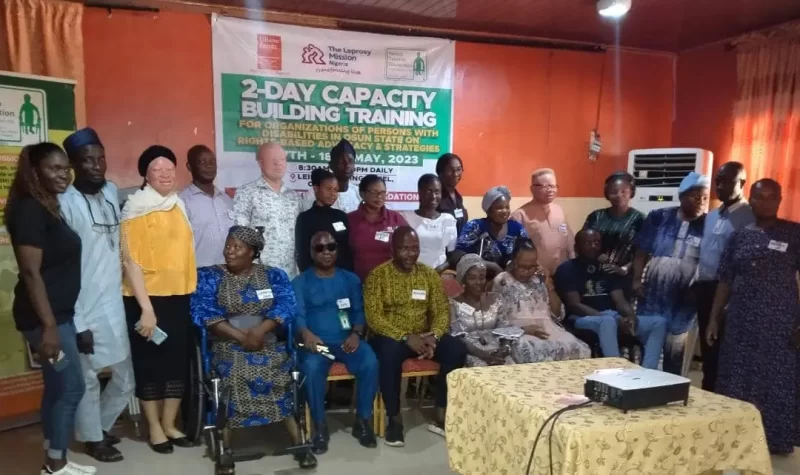Global Issues
An Appraisal Of The Discrimination Against Persons With Disabilities (Prohibition) Act 2019 -By Oyetola Muyiwa Atoyebi & Prince Igho
The Discrimination Against Persons with Disabilities (Prohibition) Act 2019 stands as a beacon of hope in the ongoing struggle for equality, dignity, and inclusion for individuals with disabilities. This groundbreaking legislation, with its unwavering commitment to human rights principles, has paved the way for positive change in various spheres of life.

INTRODUCTION
In a world that aspires for inclusivity and equality, it is depressing to realize that prejudice against people with disabilities is still prevalent. In an effort to address this longstanding concern, the Discrimination Against Persons with Disabilities (Prohibition) Act 2019 emerged as a significant milestone in Nigeria[1].
This landmark legislation seeks to protect the rights and dignity of individuals with disabilities by prohibiting discrimination across various aspects of life. This is due to the staggering population, geographical, material size, and the dynamism of our population in the face of protracted economic hardships, including safeguard and institutional challenges particularly for Nigerians with disabilities.[2]
In this article, we will delve into the nuances of the Act, exploring its key provisions, implications, and the ongoing challenges in its implementation. Through this examination, we aim to shed light on the journey towards a more inclusive and equitable society for all.
Purpose of the Discrimination Against Persons with Disabilities (Prohibition) Act 2019:
On the 17th of January 2019, the Discrimination Against Persons with Disabilities (Prohibition) Act 2018, also known as National Disability Act was signed into law.[3]The primary purpose of the DAPD Act 2019 is to ensure equal treatment, opportunities, and inclusion for persons with disabilities. This legislation strives to achieve several key objectives:
- Anti-Discrimination[4]: The Act seeks to eradicate discrimination in all its forms against individuals with disabilities. It prohibits any unfair treatment based on disability in various domains, including employment, education, healthcare, and public services.
- Promoting Inclusivity: It promotes the full inclusion of persons with disabilities in society by requiring accessibility accommodations[5], reasonable adjustments, and equal participation in public and private activities.
- Protection of Rights: The Act outlines specific rights and protections for persons with disabilities, emphasizing their right to live independently, access information, and participate fully in political[6], cultural, and social life.
- Awareness and Sensitization[7]: It encourages public awareness campaigns and educational initiatives to change societal perceptions and attitudes towards disability, fostering a more inclusive and empathetic society.
Rationale Behind Its Enactment:
Disability in Africa and across the world, is viewed in most instances as associated dependency and inability to perform basic chores. People exhibit pity for persons with disabilities when in actual fact their impairment makes little or no difference to their abilities[8]. Thus, Nigeria’s efforts in negating these issues, the realization that disability is in the mind and the need to negate discrimination[9] with the enactment of the Discrimination Against Persons with Disabilities (Prohibition) Act 2018 is driven by several compelling reasons examined anon.
- Human Rights Perspective: It aligns with international human rights standards, particularly the United Nations Convention on the Rights of Persons with Disabilities (UNCRPD). The Act reflects a commitment to upholding the fundamental human rights of all individuals, irrespective of their abilities.
- Equality and Inclusivity: It recognizes that discrimination against persons with disabilities has long perpetuated inequality and exclusion. By prohibiting such discrimination, the Act aims to create a level playing field where everyone can participate fully in society.
- Social and Economic Benefits: The Act acknowledges that inclusive policies and practices benefit society as a whole. By tapping into the talents and potential of individuals with disabilities, it fosters diversity, innovation, and economic growth.
- Global Best Practices: Many countries like Australia, Bolivia, Brazil, Canada, Germany, the United Kingdom and the United States adopted similar anti-discrimination laws, recognizing the need to align with global best practices in the field of disability rights. The Act reflects a commitment to international norms and standards.
Assessing the Impact of the Provisions of the Discrimination Against Persons with Disabilities (Prohibition) Act 2019.
The Discrimination Against Persons with Disabilities (Prohibition) Act 2019 has had a significant impact on both employment and education[10], bringing about positive changes and fostering greater inclusivity for individuals with disabilities. Here’s an overview of its impact on these crucial areas:
- Employment[11]:
Equal Opportunities: The Act mandates equal employment opportunities for persons with disabilities. Employers are required to provide reasonable accommodations, such as accessible workplaces or flexible working hours, to ensure that individuals with disabilities can perform their job duties effectively.
Inclusive Workforce: The Act has contributed to the creation of a more inclusive workforce. Employers are increasingly recognizing the value of diversity and actively seeking to hire and retain individuals with disabilities, tapping into a pool of talented and skilled workers.
Economic Empowerment: By promoting the employment of persons with disabilities, the Act has enhanced their economic empowerment and reduced dependency on social welfare programs. This, in turn, benefits the overall economy and reduces the financial burden on the state.
Accessibility: Employers are encouraged to make their workplaces accessible, not only physically but also in terms of information and communication. This ensures that individuals with disabilities can fully participate in all aspects of their work.
- Education[12]:
Inclusive Education: The Act has spurred the development of inclusive educational practices. Educational institutions, from preschools to universities, are required to provide reasonable accommodations to students with disabilities, enabling them to access quality education alongside their peers.
Accessibility of Learning Materials: Educational materials, such as textbooks and online resources, are increasingly being made accessible to students with disabilities through formats like braille, audio, and electronic texts, ensuring that they have an equitable learning experience.
Support Services: The Act has led to the provision of support services, such as sign language interpreters, special education teachers, and assistive technologies, to facilitate the learning process for students with disabilities.
Reducing Dropout Rates: By addressing discriminatory practices and enhancing support mechanisms, the Act has contributed to a reduction in dropout rates among students with disabilities, enabling more individuals to complete their education and pursue higher levels of learning.
Challenges in the Implementation and Enforcement of Discrimination Against Persons with Disabilities (Prohibition) Act 2019
The implementation and enforcement of the Discrimination Against Persons with Disabilities (Prohibition) Act 2019 is faced with several significant challenges. While this legislation is crucial for protecting the rights of individuals with disabilities, its effectiveness is hindered by various obstacles. Here are some challenges in implementing and enforcing the Act:
- Lack of Awareness and Understanding:
Many individuals and organizations do not fully understand the provisions and requirements of the Act, leading to unintentional violations. Raising awareness and providing education about the Act is crucial for compliance.
- Inadequate Resources and Support:
Government agencies responsible for enforcing the Act, face resource constraints, including limited funding and staff. This hinders their ability to effectively investigate and address discrimination cases.
- Accessibility Barriers:
Ensuring accessibility for persons with disabilities, as mandated by the Act, can be a significant challenge. Physical infrastructure, websites, and communication materials are not designed with accessibility in mind, making it difficult for individuals with disabilities to access information and services.
- Stigma and Attitudinal Barriers:
Deep-seated societal attitudes and stereotypes towards persons with disabilities persist despite legal protections. Discrimination often occurs in subtle ways, making it challenging to identify and address. Changing these attitudes requires long-term efforts.
- Inconsistent Enforcement:
Enforcement of the Act may vary from region to region or among different agencies, leading to inconsistent outcomes for individuals with disabilities. A lack of uniform enforcement can create confusion and undermine the Act’s effectiveness.
Modes to Enforce the Discrimination Against Persons with Disabilities (Prohibition) Act 2019 effectively
Enforcing the Discrimination Against Persons with Disabilities (Prohibition) Act 2019 effectively is essential to ensure the protection of the rights and dignity of individuals with disabilities. Discussed below are key modes to enforce the Act:
- Awareness and Training Programs:
- Conduct extensive awareness campaigns to educate the public, employers, educators, and service providers about the provisions and implications of the Act.
- Offer training programs to key stakeholders, including law enforcement officials and legal professionals, to enhance their understanding of disability rights and discrimination issues.
- Accessibility Standards and Compliance Monitoring:
- Develop clear and comprehensive accessibility standards that align with the Act’s requirements.
- Establish regular monitoring and inspection mechanisms to ensure that public and private entities comply with accessibility standards and make necessary accommodations.
- Reasonable Accommodation Framework:
- Implement a framework that mandates the provision of reasonable accommodations for persons with disabilities in various settings, such as workplaces, educational institutions, and public facilities.
- Create guidelines for assessing and implementing reasonable accommodations based on individual needs and circumstances.
- Data Collection and Reporting:
- Collect and analyze data on discrimination cases and their outcomes to identify trends and areas of concern.
- Publish annual reports to increase transparency and accountability, highlighting progress made in addressing discrimination and areas requiring improvement.
CONCLUSION
The Discrimination Against Persons with Disabilities (Prohibition) Act 2019 stands as a beacon of hope in the ongoing struggle for equality, dignity, and inclusion for individuals with disabilities. This groundbreaking legislation, with its unwavering commitment to human rights principles, has paved the way for positive change in various spheres of life.
However, we must acknowledge that the journey towards full implementation and realization of the Act’s potential is ongoing. Challenges persist, and concerted efforts are needed to ensure that the promises of the Act are fulfilled in practice. Continued advocacy, awareness, and collaboration among governments, organizations, and individuals are essential to sustain the momentum of progress.
Moreover, it is worthy of note that inclusivity is not merely a legal obligation, but a moral imperative. It is a call to action for societies to unite in their pursuit of a world where every individual, regardless of ability, enjoys the same rights, opportunities, and respect. Through collective dedication, the remaining barriers can be broken down, a more inclusive future built, and truly leave no one behind.
KEYWORDS
disabled, disability act Nigeria, discrimination against persons with disabilities (prohibition) act 2019
SNIPPET
The Discrimination Against Persons with Disabilities (Prohibition) Act 2019 has had a significant impact on both employment and education, bringing about positive changes and fostering greater inclusivity for individuals with disabilities.
AUTHOR: Oyetola Muyiwa Atoyebi, SAN FCIArb. (U.K)
Mr. Oyetola Muyiwa Atoyebi, SAN is the Managing Partner of O. M. Atoyebi, S.A.N & Partners (OMAPLEX Law Firm).
Mr. Atoyebi has expertise in and vast knowledge of human Rights Law and this has seen him advise and represent his vast clientele in a myriad of high-level transactions. He holds the honour of being the youngest lawyer in Nigeria’s history to be conferred with the rank of Senior Advocate of Nigeria.
He can be reached at atoyebi@omaplex.com.ng
CONTRIBUTOR: Prince Igho
Prince is a member of the Dispute Resolution Team at OMAPLEX Law Firm. He also holds commendable legal expertise in Human Rights Law and Practice.
He can be reached at prince.igho@omaplex.com.ng
[1]This bill was passed by the 8th Senate of the National Assembly on March 28, 2018, subsequently In December, it was transmitted to the president for assent and assented to by the President on the 17th of January 2019.
[2]Raja Ade Oba: Understanding Nigerian discrimination against persons with disabilities (Prohibition) Act (2018), notably known as Nigeria disability rights acts. Understanding Nigerian discrimination against persons with disabilities (Prohibition) Act (2018), notably known as Nigeria disability rights acts | Pulse Nigeria accessed on 20th September, 2023
[3]Ibid
[4] Section 1, Discrimination Against Persons with Disabilities (Prohibition) Act 2019.
[5]Section 27, Discrimination against Persons with Disabilities (Prohibition) Act 2018.
[6]Section 30, Discrimination Against Persons with Disabilities (Prohibition) Act 2018.
[7]Section 2, Discrimination Against Persons with Disabilities (Prohibition) Act 2018.
[8] Ifeyinwa Onochie: DISCRIMINATION AGAINST PERSONS LIVING WITH DISABILITIES (PROHIBITION) ACT 2018: WAY FORWARD.DISCRIMINATION AGAINST PERSONS LIVING WITH DISABILITIES (PROHIBITION) ACT 2018: WAY FORWARD | Lawyers Alert (wordpress.com) accessed on 20th September, 2023
[9]Ibid
[10] Rose Adaji and Ibim O. Dokubo,’Highlights Of Discrimination Against Persons With Disabilities (Prohibition) Act 2019’ (3rd June, 2019) Mondaq <https://www.mondaq.com/nigeria/discrimination-disability–sexual-harassment/1183236/highlights-of-discrimination-against-persons-with-disabilities-prohibition-act-2019> Accessed 20th September, 2023.
[11]Section 29, Discrimination Against Persons with Disabilities (Prohibition) Act 2019.
[12]Section 17,Discrimination Against Persons with Disabilities (Prohibition) Act 2019.



















